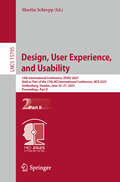Title search results
Showing 1 - 20 of 53890 items
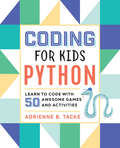
Coding for Kids: Learn to Code with 50 Awesome Games and Activities
By Adrienne B. Tacke. 2019
Games and activities that teach kids ages 10+ to code with Python Learning to code isn't as hard as it…
sounds—you just have to get started! Coding for Kids: Python starts kids off right with 50 fun, interactive activities that teach them the basics of the Python programming language. From learning the essential building blocks of programming to creating their very own games, kids will progress through unique lessons packed with helpful examples—and a little silliness! Kids will follow along by starting to code (and debug their code) step by step, seeing the results of their coding in real time. Activities at the end of each chapter help test their new knowledge by combining multiple concepts. For young programmers who really want to show off their creativity, there are extra tricky challenges to tackle after each chapter. All kids need to get started is a computer and this book. This beginner's guide to Python for kids includes: 50 Innovative exercises—Coding concepts come to life with game-based exercises for creating code blocks, drawing pictures using a prewritten module, and more. Easy-to-follow guidance—New coders will be supported by thorough instructions, sample code, and explanations of new programming terms. Engaging visual lessons—Colorful illustrations and screenshots for reference help capture kids' interest and keep lessons clear and simple. Encourage kids to think independently and have fun learning an amazing new skill with this coding book for kids.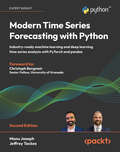
Modern Time Series Forecasting with Python: Industry-ready machine learning and deep learning time series analysis with PyTorch and pandas
By Manu Joseph, Jeffrey Tackes. 2024
Learn traditional and cutting-edge machine learning (ML) and deep learning techniques and best practices for time series forecasting, including global…
forecasting models, conformal prediction, and transformer architecturesKey FeaturesApply ML and global models to improve forecasting accuracy through practical examplesEnhance your time series toolkit by using deep learning models, including RNNs, transformers, and N-BEATSLearn probabilistic forecasting with conformal prediction, Monte Carlo dropout, and quantile regressionsPurchase of the print or Kindle book includes a free eBook in PDF formatBook DescriptionPredicting the future, whether it's market trends, energy demand, or website traffic, has never been more crucial. This practical, hands-on guide empowers you to build and deploy powerful time series forecasting models. Whether you’re working with traditional statistical methods or cutting-edge deep learning architectures, this book provides structured learning and best practices for both. Starting with the basics, this data science book introduces fundamental time series concepts, such as ARIMA and exponential smoothing, before gradually progressing to advanced topics, such as machine learning for time series, deep neural networks, and transformers. As part of your fundamentals training, you’ll learn preprocessing, feature engineering, and model evaluation. As you progress, you’ll also explore global forecasting models, ensemble methods, and probabilistic forecasting techniques. This new edition goes deeper into transformer architectures and probabilistic forecasting, including new content on the latest time series models, conformal prediction, and hierarchical forecasting. Whether you seek advanced deep learning insights or specialized architecture implementations, this edition provides practical strategies and new content to elevate your forecasting skills.What you will learnBuild machine learning models for regression-based time series forecastingApply powerful feature engineering techniques to enhance prediction accuracyTackle common challenges like non-stationarity and seasonalityCombine multiple forecasts using ensembling and stacking for superior resultsExplore cutting-edge advancements in probabilistic forecasting and handle intermittent or sparse time seriesEvaluate and validate your forecasts using best practices and statistical metricsWho this book is forThis book is ideal for data scientists, financial analysts, quantitative analysts, machine learning engineers, and researchers who need to model time-dependent data across industries, such as finance, energy, meteorology, risk analysis, and retail. Whether you are a professional looking to apply cutting-edge models to real-world problems or a student aiming to build a strong foundation in time series analysis and forecasting, this book will provide the tools and techniques you need. Familiarity with Python and basic machine learning concepts is recommended.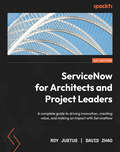
Gain insight and strategic advice for driving value in your organization with this practical guide that condenses a decade of…
ServiceNow wisdom into the must-know essentials for impactful deploymentsKey FeaturesFocus on what to do when shaping and leading a ServiceNow journeyExplore strategies for making your projects impactful and valuableGuidance for leaders at every level to maximize return on their investments in ServiceNowBook DescriptionServiceNow is the leading enterprise service management platform that enables the effective management of services in a modern enterprise.In this book, you'll learn how to avoid pitfalls that can challenge value realization, where to focus, how to balance tradeoffs, and how to get buy-in for complex decisions. You'll understand the key drivers of value in ServiceNow implementation and how to structure your program for successful delivery. Moving ahead, you'll get practical guidance on the methods and considerations in securely using ServiceNow. You'll also learn how to set up a multi-instance environment including best practices, patterns and alternatives in the use and maintenance of a multi-instance pipeline. Later chapters cover methods and approaches to design processes that deliver optimal ROI. Further, you'll receive tips for designing technical standards, designing for scale, ensuring maintainability, and building a supportable instance. Finally, you'll focus on the innovative possibilities that can be unlocked in a ServiceNow journey which will help you to manage uncertainty and claim the value of being an early adopter.By the end of this book, you'll be prepared to lead or support a ServiceNow implementation with confidence that you're bringing not only a solution but also making an impact in your organization.What you will learnUnderstand the key drivers of value in ServiceNow implementationStructure your ServiceNow programs for successful deliveryDiscover methods and tools for securely using ServiceNowSet up a multi-instance environment with best practices and patternsArchitect and lead the deployment of AI capabilities in ServiceNowBuild innovative experiences using NLU, virtual agents and the Now Experience FrameworkWho this book is forThis book is for architects, consultants and project leaders looking to drive value by applying ServiceNow effectively and efficiently. Platform administration or development experience is useful but not necessary to get the most out of this book. However, some familiarity with the modules and features of ServiceNow is expected.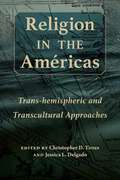
Religion in the Américas: Trans-hemispheric and Transcultural Approaches (Religions of the Americas Series)
By Christopher D. Tirres and Jessica L. Delgado. 2025
Religion in the Américas explores the fluid, dynamic, and complex nature of religion across Latin America and its diasporic communities…
in the United States. Utilizing a transdisciplinary and trans-hemispheric lens, this groundbreaking anthology transcends traditional scholarly boundaries—geographical, disciplinary, and temporal—as it explores ideas and cultural practices that share a common history of Iberian colonialism.This robust collection of essays forges a dialogue among scholars throughout the Americas who represent a variety of disciplinary perspectives. The book is divided into five sections: &“Fluidity in the Afro-Latine Diaspora,&” &“Aesthetics in Las Américas,&” &“Critical Feminist Epistemologies and Activism,&” &“The Limits of Institutional Religion,&” and &“Spiritual Invasions and Contagions.&” Throughout the volume, the concept of &“experience&” serves as a foundational lens, as chapters examine how individuals and communities actively interpret and negotiate their realities within diverse historical and social contexts.Focusing on religion as a culturally conditioned epistemic practice, Religion in the Américas invites readers to engage with religion in the Americas on multiple, intersecting levels of knowledge, including local insights, scholarly analyses, and the positionality and queries of readers themselves. The book&’s dialogical approach encourages not only continual reevaluation of the complexities of religious experience in the Americas but also creative innovation that will inspire new avenues of inquiry.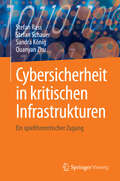
Cybersicherheit in kritischen Infrastrukturen: Ein spieltheoretischer Zugang
By Quanyan Zhu, Stefan Rass, Stefan Schauer, Sandra König. 2025
Dieses Buch stellt ein Kompendium ausgewählter spiel- und entscheidungstheoretischer Modelle zur Erreichung und Bewertung der Sicherheit kritischer Infrastrukturen vor. Angesichts…
aktueller Berichte über Sicherheitsvorfälle verschiedenster Art lässt sich ein Paradigmenwechsel hin zu immer heterogeneren Angriffen erkennen. Hierbei werden verschiedene Techniken kombiniert werden, was zu einer fortgeschrittenen, anhaltenden Bedrohung führen kann. Sicherheitsvorkehrungen müssen diesen vielfältigen Bedrohungsmustern in ebenso vielfältiger Weise gerecht werden. Als Antwort darauf bietet dieses Buch eine Fülle von Techniken zum Schutz vor und zur Abschwächung von IT-Angriffen. Ein Großteil der traditionellen Sicherheitsforschung konzentriert sich auf bestimmte Angriffsszenarien oder Anwendungen und ist bestrebt, einen Angriff "praktisch unmöglich" zu machen. Ein neueres Sicherheitskonzept betrachtet die Sicherheit als ein Szenario, in dem die Kosten eines Angriffs den möglichen Nutzen übersteigen. Dies schließt die Möglichkeit eines Angriffs nicht aus, sondern minimiert die Wahrscheinlichkeit eines solchen auf das geringstmögliche Risiko. Das Buch folgt dieser ökonomischen Definition von Sicherheit und bietet eine managementwissenschaftliche Sichtweise, die ein Gleichgewicht zwischen Sicherheitsinvestitionen und dem daraus resultierenden Nutzen anstrebt. Es konzentriert sich auf die Optimierung von Ressourcen angesichts von Bedrohungen wie Terrorismus und fortgeschrittenen, anhaltenden Bedrohungen. Ausgehend von der Erfahrung der Autoren und inspiriert von realen Fallstudien bietet das Buch einen systematischen Ansatz für die Sicherheit und Widerstandsfähigkeit kritischer Infrastrukturen. Das Buch ist eine Mischung aus theoretischer Arbeit und praktischen Erfolgsgeschichten und richtet sich vor allem an Studenten und Praktiker, die eine Einführung in spiel- und entscheidungstheoretische Techniken für die Sicherheit suchen. Die erforderlichen mathematischen Konzepte sind in sich abgeschlossen, werden rigoros eingeführt und durch Fallstudien illustriert. Das Buch bietet auch Software-Tools, die den Leser bei der praktischen Anwendung der wissenschaftlichen Modelle und Berechnungsrahmen unterstützen. Dieses Buch ist eine Übersetzung einer englischen Originalausgabe. Die Übersetzung wurde mit Hilfe von künstlicher Intelligenz (maschinelle Übersetzung durch den Dienst DeepL.com) erstellt. Eine anschließende menschliche Überarbeitung erfolgte vor allem in Bezug auf den Inhalt, so dass sich das Buch stilistisch anders liest als eine herkömmliche Übersetzung.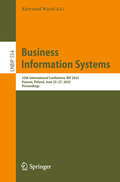
This book constitutes the proceedings of the 25th International Conference on Business Information Systems, BIS 2025, which took place in…
Poznan, Poland, during June 25-27, 2025. This year's theme was "AI-driven business transformation: challenges and opportunities". The 19 full papers and 4 short papers presented in this volume were carefully reviewed and selected from 54 submissions. The papers were organized in the following topical sections: Artificial intelligence in management; artificial intelligence for visualization; artificial intelligence for language processing; process mining; finance and privacy; data platforms and deployment; sustainable operations and smart automation.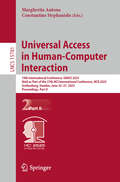
Universal Access in Human-Computer Interaction: 19th International Conference, UAHCI 2025, Held as Part of the 27th HCI International Conference, HCII 2025, Gothenburg, Sweden, June 22–27, 2025, Proceedings, Part II (Lecture Notes in Computer Science #1
By Margherita Antona, Constantine Stephanidis. 2025
This 2-volume set LNCS 15780-15781 constitutes the refereed proceedings of the 19th International Conference on Universal Access in Human-Computer Interaction,…
UAHCI 2025, held as part of the 27th International Conference, HCI International 2025, in Gothemburg, Sweden during June 22nd to 27th, 2025. The total of 1430 papers and 355 posters included in the HCII 2025 proceedings was carefully reviewed and selected from 7972 submissions. The two volumes cover topics as follows: Universal Access Theory and Practice Multimodality and UI Adaptation Universal Access and AI Inclusive Virtual and Augmented Reality Inclusive Learning and Playing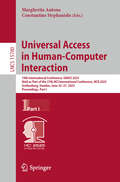
Universal Access in Human-Computer Interaction: 19th International Conference, UAHCI 2025, Held as Part of the 27th HCI International Conference, HCII 2025, Gothenburg, Sweden, June 22–27, 2025, Proceedings, Part I (Lecture Notes in Computer Science #15
By Margherita Antona, Constantine Stephanidis. 2025
This 2-volume set LNCS 15780-15781 constitutes the refereed proceedings of the 19th International Conference on Universal Access in Human-Computer Interaction,…
UAHCI 2025, held as part of the 27th International Conference, HCI International 2025, in Gothemburg, Sweden during June 22nd to 27th, 2025. The total of 1430 papers and 355 posters included in the HCII 2025 proceedings was carefully reviewed and selected from 7972 submissions. The two volumes cover topics as follows: Universal Access Theory and Practice Multimodality and UI Adaptation Universal Access and AI Inclusive Virtual and Augmented Reality Inclusive Learning and Playing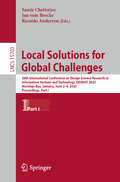
Local Solutions for Global Challenges: 20th International Conference on Design Science Research in Information Systems and Technology, DESRIST 2025, Montego Bay, Jamaica, June 2–4, 2025, Proceedings, Part I (Lecture Notes in Computer Science #15703)
By Samir Chatterjee, Jan Vom Brocke, Ricardo Anderson. 2025
The two-volume proceedings set LNCS 15703 and 15704 constitutes the refereed proceedings of the 20th International Conference on Local Solutions for…
Global Challenges, DESRIST 2025, which was held in Montego Bay, Jamaica, during June 2–4, 2025. The 36 full and 2 short papers presented in this book were carefully reviewed and selected from 111 submissions. The papers presented in these volumes are organized into the following topical sections:- Part I: Emerging DSR Methods and Novel DSR Applications; Data-Driven Design Science; DSR Education; Healthcare Systems, Ageing and Wellbeing Part II: Responsible Artificial Intelligence Design; Cybersecurity, Privacy, and Ethics; Innovation and Entrepreneurship; Sustainable Development and Environmental Solutions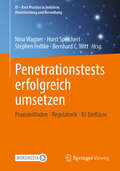
Penetrationstests erfolgreich umsetzen: Praxisleitfaden - Regulatorik - KI-Einflüsse (KI – Best Practice in Industrie, Dienstleistung und Verwaltung)
By Stephen Fedtke, Horst Speichert, Bernhard C. Witt, Nina Wagner. 2025
Dieses Buch ist ein Praxisleitfaden für Verantwortliche in Unternehmen, die Pentests erfolgreich umsetzen wollen. Dabei werden aktuelle regulatorische Anforderungen und…
Herausforderungen ebenso beleuchtet wie die unterstützende Wirkung der KI. Professionelle Dienstleister decken durch Pentests Schwachstellen in Komponenten auf, damit Betroffene diese proaktiv beheben können. Dabei werden Vorgehen und Methoden echter Angreifer angewendet. Die Autoren geben praxisnahe Tipps zum Vorgehen, beginnend bei der Planung erster Pentests bis zur Nachbereitung. Es wird in sämtlichen Phasen aufgezeigt, wie für alle Seiten ein optimaler Nutzen aus Pentest-Projekten gezogen wird, bei gleichzeitig rechtlich sicheren Rahmenbedingungen.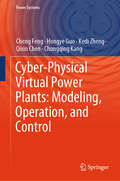
Cyber-Physical Virtual Power Plants: Modeling, Operation, and Control (Power Systems)
By Chongqing Kang, Qixin Chen, Hongye Guo, Kedi Zheng, Cheng Feng. 2025
Cyber-physical Virtual Power Plants (VPPs), a revolutionary framework designed to harness the collective potential of distributed energy resources (DERs) via…
communication technologies, are crucial for integrating large of renewable generators into future energy grids securely and cost-effectively. This is the pioneering book that systematically explains and explores the operation and control of VPPs from a cyber-physical perspective. Born out of the authors&’ continuous research and engineering practice in the field of VPPs, this book lays the theoretical foundation for the topic and thoroughly presents straightforward solutions to the challenges encountered in cyber-physical VPPs. This book is a useful reference for researchers, graduates, and engineers interested in and working on VPPs, cyber-physical system designs, and Internet of Things applications.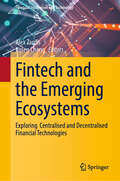
Fintech and the Emerging Ecosystems: Exploring Centralised and Decentralised Financial Technologies (Financial Innovation and Technology)
By Alex Zarifis, Xusen Cheng. 2025
Financial technologies, commonly referred to as Fintech, are revolutionizing and reorganizing the financial sector. This digital transformation profoundly impacts society…
and influences our everyday lives in numerous ways, as financial services intersect with various other services we utilize. This book offers contributions from leading researchers in the field, providing a comprehensive understanding of this multifaceted transformation. It encompasses emerging financial technologies such as cryptoassets, including Bitcoin and Non-Fungible Tokens (NFTs), Decentralized Finance (DeFi), Central Bank Digital Currencies (CBDCs), and the growing significance of Artificial Intelligence (AI) and Generative AI. While the primary audience comprises researchers and academics, practitioners and students can also glean practical insights from its contents. Chapters "A Model of Trust in Central Bank Digital Currency (CBDC) in Brazil: How Trust in a Two-Tier CBDC with Both the Central and Retail Banks Involved Changes Consumer Trust" and "Building Trust in AI: Leadership Insights from Malaysian Fintech Boards" are available open access under a Creative Commons Attribution 4.0 International License via link.springer.com.This six-volume set LNCS 15794-15799 constitutes the refereed proceedings of the 14th International Conference on Design, User Experience, and Usability,…
DUXU 2025, held as part of the 27th International Conference on Human-Computer Interaction, HCII 2025, in Gothenburg, Sweden, during June 22-27, 2025. The total of 1430 papers and 355 posters included in the HCII 2025 proceedings was carefully reviewed and selected from 7972 submissions.The six volumes cover the following topics:Part I: Information design and visualization; emotional interaction and persuasive design; and interactive systems and user behavior.Part II: UX design and evaluation methodologies; inclusive design and accessible experiences; and product and industrial design.Part III: Design and the digital transmission of culture; design for arts and creativity; and designing for health and therapeutic experiences.Part IV: Consumer experience and service design; design and evaluation of technology-enhanced learning; and UX in automotive and transportation.Part V: Design education and professional practice; and human-centered design and interactive experiences.Part VI: AI and the future of UX design; and UX in AI and emerging technologies.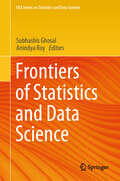
Frontiers of Statistics and Data Science (IISA Series on Statistics and Data Science)
By Subhashis Ghosal, Anindya Roy. 2025
This book addresses a diverse set of topics of contemporary interest in statistics and data science such as biostatistics and…
machine learning. Each chapter provides an overview of the topic under discussion, so that any reader with an understanding of graduate-level statistics, but not necessarily with a prior background on the topic should be able to get a summary of developments in the field. These chapters serve as basic introductory references for new researchers in these fields, as well as the basis of teaching a course on the topic, or with a part of the course on topics of precision medicine, deep learning, high-dimensional central limit theorems, multivariate rank testing, R programming for statistics, Bayesian nonparametrics, large deviation asymptotics, spatio-temporal modeling of Covid-19, statistical network models, hidden Markov models, statistical record linkage analysis. The edited volume will be most useful for graduate students looking for an overview of any of the covered topics for their research and for instructors for developing certain courses by including any of the topics as part of the course. Students enrolled in a course covering any of the included topics can also benefit from these chapters.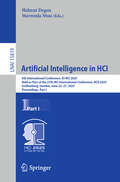
The four-volume set LNAI 15819–15822 constitutes the thoroughly refereed proceedings of the 6th International Conference on Artificial Intelligence in HCI,…
AI-HCI 2025, held as part of the 27th International Conference, HCI International 2025, which took place in Gothenburg, Sweden, June 22-17, 2025. The total of 1430 papers and 355 posters included in the HCII 2025 proceedings was carefully reviewed and selected from 7972 submissions. The papers have been organized in topical sections as follows: Part I: Trust and Explainability in Human-AI Interaction; User Perceptions, Acceptance, and Engagement with AI; UX and Socio-Technical Considerations in AI Part II: Bias Mitigation and Ethics in AI Systems; Human-AI Collaboration and Teaming; Chatbots and AI-Driven Conversational Agents; AI in Language Processing and Communication. Part III: Generative AI in HCI; Human-LLM Interactions and UX Considerations; Everyday AI: Enhancing Culture, Well-Being, and Urban Living. Part IV: AI-Driven Creativity: Applications and Challenges; AI in Industry, Automation, and Robotics; Human-Centered AI and Machine Learning Technologies.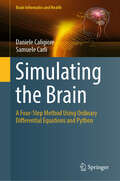
Simulating the Brain: A Four-Step Method Using Ordinary Differential Equations and Python (Brain Informatics and Health)
By Daniele Caligiore, Samuele Carli. 2025
This book presents a new methodology to develop system-level brain models using ordinary differential equations (ODE), which are to be…
solved and analyzed through simple Python scripts. Computer simulations of this kind of models allow the study of healthy and damaged brain functions, the discovery of new neural pathways that may be crucial for the emergence of pathologies, and to simulate the effects of possible new therapies acting on brain actors which are difficult to investigate in traditional research.The methodology consists of four steps: (i) design the model architecture which represents the interactions between different brain areas; (ii) write the ODE system which are implied by the model; (iii) build a Python script that correctly solves the equations; (iv) optimize the free model parameters using genetic algorithms or other techniques to obtain one or more model instances that reproduce the target investigated behavior.This book is for all people who want to learn how to use Python and ODE to simulate brain functions regardless of their backgrounds. While rigorous mathematical proofs of many aspects of the arguments discussed are out of the scope of this work and are therefore omitted, the most important concepts necessary for the critical judgment and self-assessment of the practitioner’s work are exposed in a simplified, readily applicable form, with extensive references for the adventurous reader to explore. The book is a self-consistent textbook containing all pieces necessary to learn from scratch: from the essential mathematical and computing tools to the knowledge necessary to design, simulate, visualize, and interpret brain models. These skills are acquired through several hands-on examples explained step-by-step. One important and distinctive aspect of the book is that, beside the theory, it provides the necessary contexts and practical examples which are key to the correct application of the proposed methodology.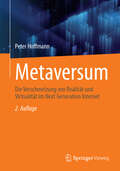
Metaversum: Die Verschmelzung von Realität und Virtualität im Next Generation Internet
By Peter Hoffmann. 2025
Die Entwicklung des Internets, insbesondere des WWW, stößt aktuell an ihre Grenzen – sowohl technisch als auch sozio-kulturell und ökonomisch.…
Als Lösung wird ein neues Internet versprochen, das die Grenzen der realen und der virtuellen Welt überwinden und Realität und Digitalität verschmelzen soll – das Metaversum. Technische, semantische und organisatorische Details greifen hierzu eng ineinander. Was aber bedeutet dies bei genauerer Betrachtung? Welche technisch-technologischen Herausforderungen müssen bewältigt werden, um ein solches Verschmelzen zu erreichen? Welche ökonomischen Möglichkeiten eröffnen sich– und welche verbieten sich möglicherweise? Wie kann erreicht werden, dass ein offenes und für jeden benutzbares Metaversum entsteht? Und wie kann vermieden werden, dass auch in diesem neuen Metaversum wenige große Anbieter ihre proprietären Ideen durchsetzen? Für diese Fragen soll dieses Buch Antworten aufzeigen. In der vorliegenden Auflage wurden zudem aktuelle Trends sowie der Beitrag der künstlichen Intelligenz zum Metaversum ergänzt.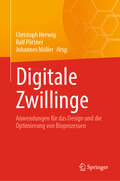
Digitale Zwillinge: Anwendungen für das Design und die Optimierung von Bioprozessen
By Ralf Pörtner, Christoph Herwig, Johannes Möller. 2025
Dies ist der zweite von zwei Bänden, die zusammen einen Überblick über die neuesten Fortschritte bei der Erzeugung und Anwendung…
digitaler Zwillinge in der Bioprozessentwicklung und -optimierung geben. Bioprozesse haben sich in den letzten Jahrzehnten stark entwickelt, von datengetriebenen Ansätzen hin zur Digitalisierung der Bioprozessindustrie im 21. Jahrhundert. Darüber hinaus erfordert die hohe Nachfrage nach biotechnologischen Produkten effiziente Methoden, sowohl in der Forschung und Entwicklung als auch im Technologietransfer und in der Routineproduktion. Ein vielversprechendes Werkzeug ist in diesem Zusammenhang der Einsatz von digitalen Zwillingen als virtuelle Darstellung des Bioprozesses. Sie spiegeln die Mechanik des biologischen Systems, die Wechselwirkungen zwischen Prozessparametern, Kennzahlen und Produktqualitätsmerkmalen in Form eines mathematischen Prozessmodells wider. Darüber hinaus ermöglichen digitale Zwillinge den Einsatz computergestützter Methoden, um ein besseres Prozessverständnis zu erlangen, neuartige Bioprozesse zu testen und zu planen sowie diese effizient zu überwachen. Dieses Buch konzentriert sich auf die Anwendung digitaler Zwillinge in verschiedenen Kontexten, z.B. computergestützte Versuchsplanung, Seed-Train-Vorhersage und Lifeline-Analyse. Die beiden Bände behandeln sowohl die Grundlagen als auch die Anwendungen und bieten damit eine ideale Einführung in das Thema für Forscher und Entwickler in Wissenschaft und Industrie.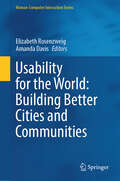
Usability for the World: Building Better Cities and Communities (Human–Computer Interaction Series)
By Amanda Davis, Elizabeth Rosenzweig. 2025
Want to build cities that truly work for everyone? Usability for the World: Sustainable Cities and Communities reveals how human-centered…
design is key to thriving, equitable urban spaces. This isn't just another urban planning book; it's a practical guide to transforming cities, offering concrete strategies and real-world examples you can use today. What if our cities could be both efficient and human-friendly? This book tackles the core challenge of modern urban development: balancing functionality with the well-being of residents. It explores the crucial connection between usability and sustainability, demonstrating how design principles, from Universal to life-centered, create truly livable cities. Interested in sustainable urban development? Usability for the World offers a global perspective, showcasing diverse approaches to creating equitable and resilient cities. Through compelling case studies, discover how user-centered design addresses pressing urban challenges. See how these principles connect directly to achieving the UN Sustainable Development Goals, specifically SDG 11: Sustainable Cities and Communities. This book offers more than theory. It provides practical insights and actionable strategies for: Designing user-centered cities: Apply usability principles to urban planning. Improving urban spaces: Discover how tech and innovation create human-friendly environments. Building sustainable communities: Explore the link between human-centered design and the SDGs. Creating equitable cities: Understand how design promotes inclusivity and accessibility. Whether you're an urban planner, designer, policymaker, or simply someone who cares about our cities' future, Usability for the World provides the tools and inspiration you need. Join the movement to build better cities, one human-centered design at a time. What will your contribution be to the future of urban living?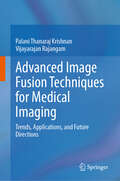
Advanced Image Fusion Techniques for Medical Imaging: Trends, Applications, and Future Directions
By Palani Thanaraj Krishnan, Vijayarajan Rajangam. 2025
"Advanced Image Fusion Techniques for Medical Imaging: Trends, Applications, and Future Directions" is a comprehensive exploration of cutting-edge image fusion…
methodologies in the realm of medical imaging. This timely work addresses the growing need for advanced techniques to integrate and analyze multi-modal medical images, offering healthcare professionals and researchers a valuable resource for improving diagnostic accuracy and patient outcomes. The book provides a thorough examination of both conventional and deep learning-based fusion strategies, covering a wide spectrum of applications in medical image processing. From noise reduction and image enhancement to segmentation and classification, the authors present a detailed analysis of how image fusion can be leveraged to overcome the limitations of individual imaging modalities. Real-world case studies and practical examples throughout the text demonstrate the tangible benefits of these techniques in clinical settings. Looking beyond current applications, this forward-thinking volume also explores emerging trends and future directions in medical image fusion. By addressing challenges and potential impacts on healthcare practices, the authors offer readers a glimpse into the future of medical imaging. This book serves as an essential guide for researchers in biomedical engineering, medical professionals specializing in radiology and medical imaging, and graduate students in computer science, electrical engineering, biomedical engineering. This diverse audience reflects the book's comprehensive approach to advanced image fusion techniques in medical imaging, covering both theoretical foundations and practical applications.